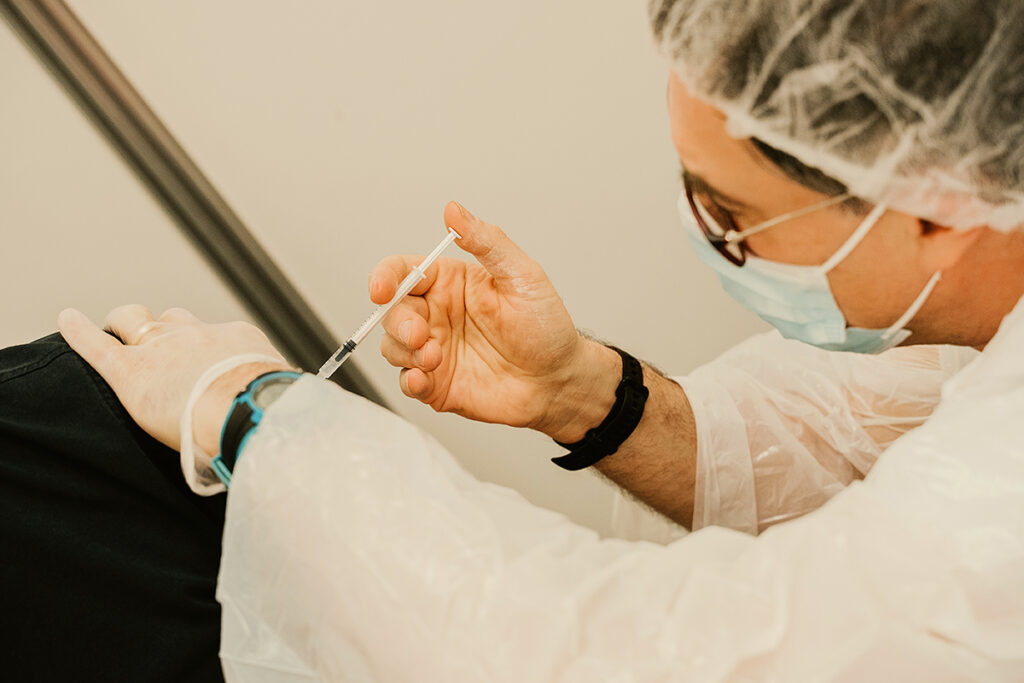The first coronavirus vaccines were introduced in late 2020 and early 2021, offering robust antibody responses primarily targeting the spike protein of the virus. These vaccines played a crucial role in saving countless lives. However, antibody levels dwindled 10-15 times within the first few months post-vaccination. During this period, the coronavirus continued to evolve, altering the amino acid composition of the spike protein, thereby diminishing the initial vaccine’s efficacy. In the spring and summer of 2021, the decline in antibody levels among vaccinated individuals coincided with the emergence and spread of the Delta variant.
The efficacy of protection against COVID-19 can be gauged through the levels of neutralizing antibodies. Following vaccination, antibody levels gradually decrease over several months, after which they stabilize around 6-9 months. This pattern arises from the B-cell response to vaccination dynamics, as these cells differentiate into short-lived plasmablasts and long-lived plasma cells. The initial wave of antibodies is generated by short-lived plasmablasts, which decrease by half within several weeks. Subsequently, long-lived plasma cells in the bone marrow produce antibodies.
Figure. Dynamics of B cell and antibody responses to the COVID-19 vaccine
Image source: https://www.science.org/doi/10.1126/science.adh2712
Reducing neutralizing antibodies’ levels heightens the risk of breakthrough infections, particularly with new coronavirus strains. Booster vaccine doses enhance antibody titers, raising them to sustained levels.
New Vaccines Against Omicron and Its Subvariants
The ability of new coronavirus strains to elude the immune response has reduced the effectiveness of vaccines. The Delta variant, for instance, proliferates rapidly in the upper respiratory tract and features a shorter incubation period between infection and symptom onset. An individual infected with the Delta variant sheds higher viral loads, capable of suppressing existing immunity, thereby increasing the risk of breakthrough infections. The shorter incubation period implies that the immune response may not have time to rebound before symptoms appear.
The Omicron variant and its subvariants have even shorter incubation periods than Delta. Moreover, Omicron displays significant genetic divergence from the ancestral coronavirus strain upon which vaccines were developed.
In response to Omicron, new vaccines have been developed:
- In the fall of 2022, the United States Food and Drug Administration (FDA) licensed updated vaccines containing spike proteins from the ancestral and Omicron strains.
- The European Medicines Agency (EMA) approved the first bivalent vaccine containing spike proteins from the ancestral strain and the Omicron BA.1 variant, subsequently licensing another bivalent vaccine with spike proteins from the ancestral strain and the Omicron BA.5 variant.
Clinical trials comparing ancestral vaccines with bivalent vaccines containing spike proteins from the BA.1 and BA.5 variants (Moderna and Pfizer) and monovalent vaccines with spike proteins from the Omicron BA.1 strain (Pfizer) revealed that these updated vaccines yield superior neutralizing antibody responses against Omicron BA.1. Interestingly, the monovalent vaccine featuring the Omicron BA.1 spike protein demonstrated better results than the bivalent vaccine.
Studies comparing bivalent vaccines with spike proteins from the ancestral strain and the Omicron BA.5 variant to monovalent ancestral booster vaccines produced inconsistent findings. In some studies, antibody titers against Omicron BA.5 were only slightly higher for the updated vaccines, while in others, the differences were significant. These discrepancies might be attributed to the possibility that individuals who underwent monovalent booster vaccination encountered breakthrough infections, which could influence the comparisons.
The introduction of these vaccines in Europe allowed for a direct comparison of antibody titers between bivalent BA.1 and BA.5 vaccines. The bivalent BA.5 vaccine modestly alters the response to Omicron BA.5, whereas the bivalent BA.1 vaccine does not affect the reaction to Omicron BA.1, possibly due to its lower immunogenicity.
The ongoing research and development of updated vaccines show promise in addressing the evolving challenges of the Omicron variant and its subvariants. These advancements emphasize the importance of adaptive strategies to protect against COVID-19 effectively.
How Will the Immune System Respond to the Updated Vaccine: Omicron or Shared Ancestral Fragments?
The influenza virus instills immunological memory within the body, responding to epitopes shared between the original and new flu strains with a partially reformed, strain-specific response.
For two-valent COVID-19 vaccines, antibody titers consist of antibodies specific to the ancestral spike and antibodies that exhibit cross-reactivity between the ancestral spike and Omicron BA.5. However, particular antibodies to Omicron BA.5 have not been identified. This indicates that the response to the two-valent BA.5 vaccine primarily centers around shared epitopes of the ancestral strain and Omicron.
A similar outcome was observed in a study of spike monoclonal antibodies derived from the memory B cells of individuals who received the monovalent BA.1 vaccine. Only 6 out of 378 spike monoclonal antibodies recognized the spike protein of BA.1 but not the ancestral strain. The rest identified both spike proteins.
These facts confirm that antibodies specific to BA.1 and BA.5 are not detectable in blood serum after revaccination. However, the immune system can generate BA.1- and BA.5-specific memory B cells, which become part of the memory B cell pool. Cross-reactive memory B cells can effectively produce neutralizing antibodies that bind to new coronavirus strains. Potently neutralizing cross-reactive antibodies provides protection as effectively as strain-specific neutralizing antibodies when both types of antibodies are present at the same titer.
The Necessity of Including the Ancestral Strain in Booster Vaccines
Cross-reactive memory B cells can produce neutralizing antibodies that effectively bind to the ancestral and new coronavirus strains. Hence, there is no need to include the ancestral strain in booster vaccines.
In the fall of 2023, the FDA, EMA, and the World Health Organization (WHO) recommended updating COVID-19 vaccines and offering annual booster doses containing the latest strains, following a similar model to the influenza virus vaccines. In the autumn of 2023, there is no rationale for incorporating the original strain into the updated booster doses. Consequently, the FDA, EMA, and WHO advocate for a monovalent vaccine based on the Kraken strain, a subvariant of Omicron.
How Often to Receive Updated Vaccines
Implementing an annual booster vaccination is more manageable than a specialized vaccination for new strains. Healthy individuals may not require yearly revaccination, with booster vaccination only necessary if a more virulent strain emerges. In such cases, administering two vaccine doses a month apart can strengthen the strain-specific immune response.
Conversely, individuals with underlying conditions and a risk of severe COVID-19 can benefit from regular annual booster vaccination, reinforcing protection against severe COVID-19 regardless of the circulating strain.
Useful article, necessary information? Share it!
Someone will also find it useful and necessary:
Reference
Variant-adapted COVID-19 booster vaccines



